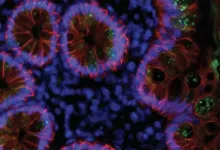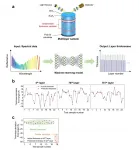(Press-News.org) ITHACA, N.Y. - Far below the gaseous atmospheric shroud on Saturn's largest moon, Titan, lies Kraken Mare, a sea of liquid methane. Cornell University astronomers have estimated that sea to be at least 1,000-feet deep near its center - enough room for a potential robotic submarine to explore.
After sifting through data from one of the final Titan flybys of the Cassini mission, the researchers detailed their findings in "The Bathymetry of Moray Sinus at Titan's Kraken Mare," which published in the Journal of Geophysical Research.
"The depth and composition of each of Titan's seas had already been measured, except for Titan's largest sea, Kraken Mare - which not only has a great name, but also contains about 80% of the moon's surface liquids," said lead author Valerio Poggiali, research associate at the Cornell Center for Astrophysics and Planetary Science (CCAPS).
A billion miles from Earth, frigid Titan is cloaked in a golden haze of gaseous nitrogen. But peeking through the clouds, the moonscape has an Earthlike appearance, with liquid methane rivers, lakes and seas, according to NASA.
The data for this discovery was gathered on Cassini's T104 flyby of Titan on Aug. 21, 2014. The spacecraft's radar surveyed Ligeia Mare - a smaller sea in the moon's northern polar region - to look for the mysteriously disappearing and reappearing "Magic Island."
While Cassini cruised at 13,000 mph nearly 600 miles above Titan's surface, the spacecraft used its radar altimeter to measure the liquid depth at Kraken Mare and Moray Sinus, an estuary located at the sea's northern end. The Cornell scientists, along with engineers from NASA's Jet Propulsion Laboratory, had figured out how to discern lake and sea bathymetry (depth) by noting the radar's return time differences on the liquid surface and sea bottom, as well as the sea's composition by acknowledging the amount of radar energy absorbed during transit through the liquid.
It turns out that Moray Sinus is about 280 feet deep, shallower than the depths of central Kraken Mare, which was too deep for the radar to measure. Surprisingly the liquid's composition, primarily a mixture of ethane and methane, was methane-dominated and similar to the composition of nearby Ligeia Mare, Titan's second-largest sea.
Earlier scientists had speculated that Kraken may be more ethane rich, both because of its size and extension to the moon's lower latitudes. The observation that the liquid composition is not markedly different from the other northern seas is an important finding that will help in assessing models of Titan's Earth-like hydrologic system.
Beyond deep, Kraken Mare also is immense - nearly the size of all five Great Lakes combined.
Titan represents a model environment of a possible atmosphere of early Earth, Poggiali said.
One puzzle is the origin of the liquid methane. Titan's solar light - about 100 times less intense than on Earth - constantly converts methane in the atmosphere into ethane; over roughly 10 million-year periods, this process would completely deplete Titan's surface stores, according to Poggiali.
In the distant future, a submarine - likely without a mechanical engine - will visit and cruise Kraken Mare, Poggiali said.
"Thanks to our measurements," he said, "scientists can now infer the density of the liquid with higher precision, and consequently better calibrate the sonar aboard the vessel and understand the sea's directional flows."
INFORMATION:
NASA provided funding for this research.
University of Illinois Chicago is one of the U.S. sites participating in clinical trials to cure severe red blood congenital diseases such as sickle cell anemia or Thalassemia by safely modifying the DNA of patients' blood cells.
The first cases treated with this approach were recently published in an article co-authored by Dr. Damiano Rondelli, the Michael Reese Professor of Hematology at the UIC College of Medicine. The article reports two patients have been cured of beta thalassemia and sickle cell disease after their own genes were edited with CRISPR-Cas9 technology. The two researchers ...
New research from McMaster University has found that psychiatric help for mothers with postpartum depression results in healthy changes in the brains of their babies.
The study, published in the journal Depression and Anxiety this week, found treating mothers who had postpartum depression with cognitive behavioural therapy (CBT) not only helped the moms, but resulted in adaptive changes in the brains and behaviour of their infants.
More specifically, after the mothers' treatment, their infants showed healthy changes in their nervous and cardiovascular systems, and they were observed to better regulate their behaviours and emotions by both mothers and fathers.
"In fact, we found that after their moms were treated that their infant's ...
As the number of people who have fought off SARS-CoV-2 climbs ever higher, a critical question has grown in importance: How long will their immunity to the novel coronavirus last? A new Rockefeller study offers an encouraging answer, suggesting that those who recover from COVID-19 are protected against the virus for at least six months, and likely much longer.
The findings, published in Nature, provide the strongest evidence yet that the immune system "remembers" the virus and, remarkably, continues to improve the quality of antibodies even after the infection has waned. Antibodies produced ...
BIRMINGHAM, Ala. - University of Alabama at Birmingham polymer and radionuclide chemists report what they say "may represent a major step forward in microcapsule drug delivery systems."
The UAB microcapsules -- labeled with radioactive zirconium-89 -- are the first example of hollow polymer capsules capable of long-term, multiday positron emission tomography, or PET, imaging in vivo. In previous work, UAB researchers showed that the hollow capsules could be filled with a potent dose of the cancer drug doxorubicin, which could then be released by therapeutic ultrasound that ruptures the microcapsules.
PET imaging with zirconium-89 -- which has a half-life of 3.3 days -- allowed the capsules to be traced in test mice up to seven days. The major ...
NASA-funded research on the 11 largest freshwater lakes in the world coupled field and satellite observations to provide a new understanding of how large bodies of water fix carbon, as well as how a changing climate and lakes interact.
Scientists at the Michigan Tech Research Institute (MTRI) studied the five Laurentian Great Lakes bordering the U.S. and Canada; the three African Great Lakes, Tanganyika, Victoria and Malawi; Lake Baikal in Russia; and Great Bear and Great Slave lakes in Canada.
These 11 lakes hold more than 50% of the surface freshwater that millions of people and countless other creatures rely on, underscoring the importance of understanding how they are being altered by climate change and other factors.
The two Canadian lakes ...
BUFFALO, N.Y. -- In the dark waters of Lake Superior, a fish species adapted to regain a genetic trait that may have helped its ancient ancestors see in the ocean, a study finds.
The research focuses on kiyis, which inhabit Lake Superior at depths of about 80 to over 200 meters deep. These fish, known to scientists as "Coregonus kiyi," belong to a group of closely related salmonids known as ciscoes.
In contrast to three other Lake Superior ciscoes that dwell and feed in shallower regions of water, the kiyis are far more likely to carry a version of the rhodopsin gene that probably improves vision in dim "blue-shifted" waters, ...
Curtin University researchers have uncovered a method of making silicon, found commonly in electronics such as phones, cameras and computers, at room temperature.
The new technique works by replacing extreme heat with electrical currents to produce the same chemical reaction that turns silica into silicon at a reduced economic and environmental cost.
Lead researcher, PhD candidate Song Zhang from Curtin's School of Molecular and Life Sciences said that while the team's discovery was made at the nanoscale, it defines a way of replacing thermochemical processes with electrochemical processes, which ...
With the recent explosive demand for data storage, ranging from data centers to various smart and connected devices, the need for higher-capacity and more compact memory devices is constantly increasing. As a result, semiconductor devices are now moving from 2D to 3D. The 3D-NAND flash memory is the most commercially successful 3D semiconductor device today, and its demand for supporting our data-driven world is now growing exponentially.
The scaling law for 3D devices is achieved by stacking more and more semiconductor layers, well above 100 layers, in a more reliable way. As each layer thickness corresponds to the effective channel length, accurate characterization and control of layer-by-layer thickness is critical. To date, ...
Giant ambush-predator worms, possible ancestors of the 'bobbit worm', may have colonized the seafloor of the Eurasian continent around 20 million years ago. The findings, based on the reconstruction of large, L-shaped burrows from layers of seafloor dating back to the Miocene (23 million to 5.3 million years ago) of northeast Taiwan, are reported in Scientific Reports this week.
Ludvig Löwemark and colleagues reconstructed a new trace fossil, which they name Pennichnus formosae, using 319 specimens preserved within layers of seafloor formed during the Miocene era across northeast Taiwan. Trace fossils are geological features such as burrows, track marks and plant root cavities preserved ...
BOSTON - Four years after patients with melanoma were treated with a personalized cancer vaccine, the immune response kindled by the vaccine remains robust and effective in keeping cancer cells under control, researchers at Dana-Farber Cancer Institute, Brigham and Women's Hospital, and the Broad Institute of MIT and Harvard report in a new study.
The findings, published online today by the journal Nature Medicine, demonstrate the staying power of the immune response generated by the vaccine, known as NeoVax, which works by targeting specific proteins on each patient's tumor cells. The researchers found that, nearly four ...



